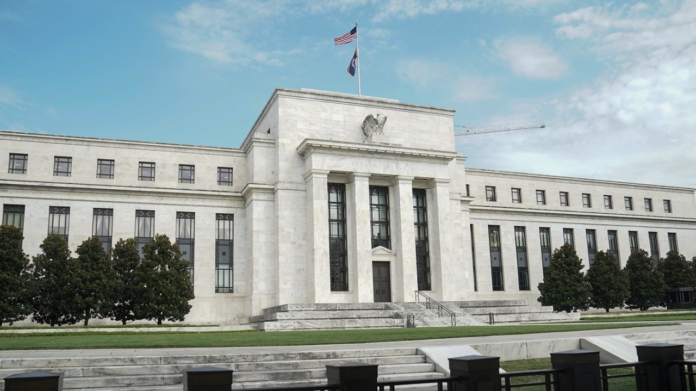Fast economic growth solves problems. Slow growth causes them. China is trying to speed up growth again after Xi’s disastrous COVID-related mistakes while the Federal Reserve is raising interest rates and slamming on the brakes to fight inflation. China’s commitment to growth while the Fed goes in the opposite direction should worry Americans profoundly.
Fast growth is the foundation of progress. Electric vehicle and chip plants, roads and transportation systems get built and better jobs will come with them as President Biden’s infrastructure legislation will demonstrate. Fast growth eases transitions from old to new types of work. People are drawn from low wage jobs into better ones. Employers train employees in new skills to retain them. The belief that the Fed has to slow growth to fight inflation is poisonous because it makes change more difficult. It also is a narrative that always ends with inflation being blamed on high wages for working people.
Fed Chairman Jerome Powell and the Federal Reserve see fast growth as inflationary, so they have raised interest rates sharply to slow it. They want the stock market to fall further along with housing prices and rents. Most of them know in their bones that slow growth gives employers more control over employees, but they don’t advertise it. Fast growth on the other hand empowers working people. It makes employers pay childcare workers more and makes “essential workers” like teachers, fire and police, carpenters and plumbers, and people in the hospitality sector more expensive.
Media attention to the Fed’s high interest rates/slow growth approach as the cure for inflation also crowds out attention to problems in specific economic sectors that monetary policy can’t solve. Market manipulation by the OPEC cartel plus Russia was a principal driver of inflation from 2020 through mid-2022. It was an even more powerful driver of the inflation of the 1973-1981 period. Slowing the whole economy by raising interest rates will do little to curb the market power of the energy cartel. What has long been needed is an alternative energy policy and investment, an approach that the fossil fuel industries don’t like and is outside the Fed’s monetarist narrative.
The narrative that glorifies the role of the Fed also takes our eyes off the insider relationships and conflicts of interest in corporate America. These have led to huge and unwarranted compensation packages for CEOs, allied denizens of the C-suites, and top 0.1 percent professionals who surround CEOs. The undemocratic distortions that this concentrated power and wealth creates is a political problem that the Fed’s monetary policy also hides.
The inflation narrative matters enormously. The explanation for the causes and cures for inflation that dominates today is built on a misunderstanding of the causes of inflation in the 1950s, ’60s and ’70s. The post-World War II U.S. economy was built around oligopolistic companies and powerful unions that had emerged from the Great Depression and the war. These oligopolies could push up prices year after year in large swaths of the economy including manufacturing (the auto and steel complex), trucking, rail, and airlines, telecommunications, banking, and even retailing.
Leaders in both parties at the time recognized the inflationary problem that these oligopolies were causing and took political risks to break their power. Presidents Ford, Carter, Reagan, the Congress, and the courts opened these areas to more competition in the 1970s and 80s which essentially eliminated inflation as an issue from 1983 until 2020. While these pro-competitive changes greatly reduced the danger of inflation, the story around them never replaced the monetarist narrative that dominates today. That narrative gives Paul Volcker, Fed chairman from 1979 to 1987 all the credit for bringing inflation down after 1983 by raising interest rates very high. This exaggeration is a pre-condition for the out-sized belief in Fed monetary policy today.
When monetary policy is seen as the only tool for dealing with inflation corporate America escapes responsibility. Trivial discussions of whether rates will go up 0.5 or 0.75 percent, when and how many times, take attention away from the problematic decisions of corporate leaders to rush overseas in search of low wages, rely on vulnerable supply chains, promote financialization at the expense of domestic production and research, endorse a self-serving emphasis on shareholder value, and to sell off cutting-edge technologies like numerically controlled machine tools to companies in Japan, Taiwan, and Germany whose leaders took a longer view. These decisions by corporate leaders and laws their allies pushed through Congress and the courts give these leaders with their deep pockets huge influence. They escape from public and media supervision because monetary policy creates a smokescreen behind which they can hide.
Neither higher interest rates nor cuts in government spending are needed in early 2023 to slow inflation. Prices are already stabilizing and falling in many sectors. The Consumer Price Index (CPI) released in December 2022, showed prices rising only 0.1 percent between October and November. Post-COVID bottlenecks have been cleared and pent-up demand is being worked off. Gasoline prices have dropped below year-ago levels. Ocean freight rates are lower than pre-COVID levels. High tech companies, fearful of a Fed-caused recession, are laying off thousands of employees. The Wall Street Journal and other publications are full of stories of moderating prices, rents and hiring. The Fed though is hell-bent on slowing growth more, so it is promising additional rate increases in the new year. Its perverse concern with rising wages is essentially where the monetarist inflation story always ends up.
If U.S. growth slows because of rising interest rates and China’s public facilities and industries continue to modernize faster than our own, the blame should be placed squarely on the Fed’s swollen role. The U.S. needs an alternative fast growth narrative to deal with inflation that should be built around investment in modern infrastructure and more competition in areas where everyone ought to recognize that “the fix is in.” If the Fed’s monetary narrative continues to dominate U.S. policy, the U.S. will pay a high price.
Paul A. London, Ph.D., was a senior policy adviser and deputy undersecretary of Commerce for Economics and Statistics in the 1990s, a deputy assistant administrator at the Federal Energy Administration and Energy Department, and a visiting fellow at the American Enterprise Institute. A legislative assistant to Sen. Walter Mondale (D-Minn.) in the 1970s, he was a foreign service officer in Paris and Vietnam and is the author of two books, including “The Competition Solution: The Bipartisan Secret Behind American Prosperity” (2005).



